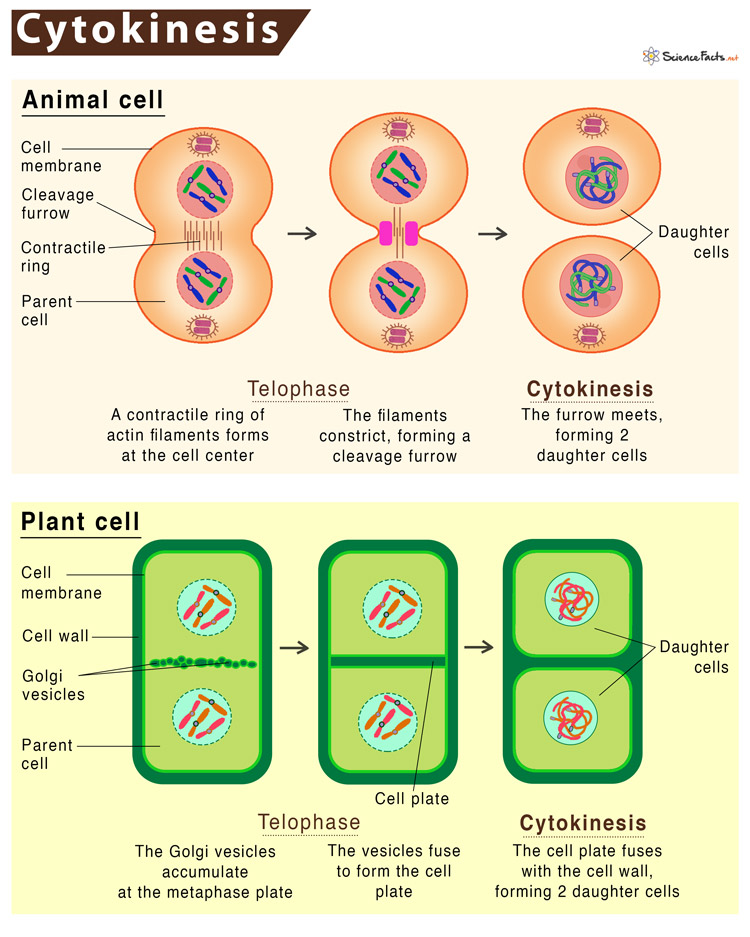Cytokinesis
Cytokinesis is the final step of the cell division process of a eukaryotic cell when the parent cell cytoplasm divides to form two daughter cells. It occurs in tandem with two types of nuclear divisions: mitosis and meiosis. The primary purpose of cytokinesis is to ensure that one nucleus ends up in each daughter cell after division.
The process can be symmetrical, where the daughter cells get an equal share of the mother cell cytoplasm or asymmetrical when the cytoplasm is divided unequally. For example, the process of spermatogenesis in males is symmetrical, producing millions of sperms, all of the equal size. In contrast, oogenesis in females is asymmetrical, producing one large egg cell with mostly mother cell cytoplasm and three small cells called polar bodies.
Cytokinesis in eukaryotes hugely resembles the prokaryotic process of binary fission in many ways. However, the exact mechanism differs due to their cell structure and functions.
What Happens during Cytokinesis
The process of cytokinesis is quite different within eukaryotes. It has two main types: one occurs in an animal cell by forming the cleavage furrow, and another occurs by plate formation in a plant cell. The four primary stages of cytokinesis are initiation, contraction, membrane insertion, and completion. The mechanism occurring within these stages differs in animal and plant cells. It is complete with the formation of two new daughter cells.
Cytokinesis in Animal Cells
Due to the lack of cell walls, cytokinesis in animal cells begins in anaphase and terminates in telophase. It follows the following stages:
- A contractile ring made of actin filaments forms just beneath the cell membrane around the center of the cell.
- The actin filaments constrict, which deepens from the periphery towards the center, forming a fissure or cleavage furrow.
- The contractile ring continues to contract till the two daughter cells are separated by the midbody, a narrowed region of the cytoplasm connecting the two daughter cells.
- When the furrow meets in the center, the cell becomes completely pinched off, forming two daughter cells bound by its cell membrane.
As the separation starts outside and moves towards the cell’s center, cytokinesis in animal cells is called centripetal cytokinesis.
Cytokinesis in Plant Cells
Since a plant cell contains a cell wall, cytokinesis starts during interphase and terminates in telophase. It follows the following stages:
- The Golgi apparatus accumulates enzymes, structural proteins, and glucose before breaking into vesicles and dispersing throughout the cell.
- The Golgi vesicles are transported to the metaphase plate during telophase, forming a vesicular structure called phragmoplast.
- Then, the vesicles fuse and begin to form a structure called the cell plate.
- The cell plate extends outwards and fuses with the cell wall, dividing the cell forming two new daughter cells, each bound by its cell membrane.
As the separation starts in the center and moves laterally to the outside, cytokinesis in animal cells is called centrifugal cytokinesis.
FAQs
Ans. Cytokinesis occurs concurrently with the telophase of mitosis.
Ans. In meiosis, cytokinesis must occur twice: once after telophase I and again after telophase II.
Ans. The main difference is that telophase is the final step of karyokinesis, forming two daughter nuclei. In contrast, cytokinesis is the final step of cell division, equally distributing cytoplasm between the two daughter nuclei.
-
References
Article was last reviewed on Friday, February 17, 2023




